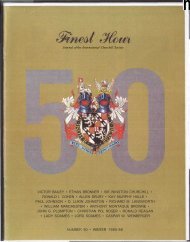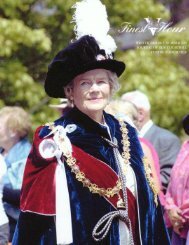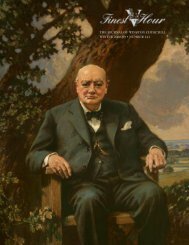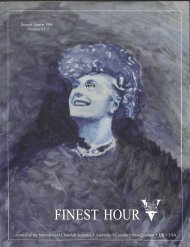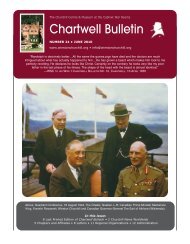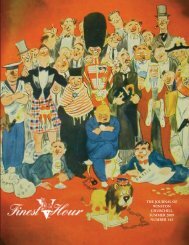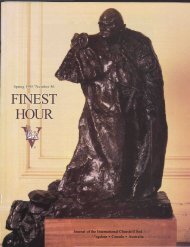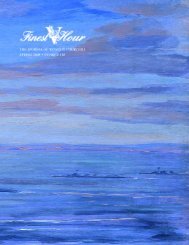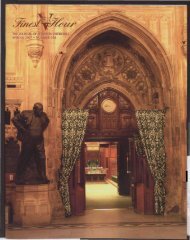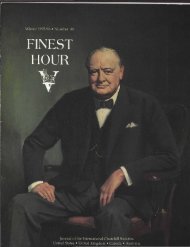You also want an ePaper? Increase the reach of your titles
YUMPU automatically turns print PDFs into web optimized ePapers that Google loves.
MEMORIES OF COMMANDO...<br />
photograph and held it for a moment. Then she asked,<br />
“Was your father in the British army”<br />
“No, he is an American, a civilian.”<br />
She studied the photograph—a portrait of a rather<br />
portly man in a three-piece suit with an inscription that<br />
read: “To Captain Vanderkloot with fond memories of<br />
Commando. —<strong>Winston</strong> S. <strong>Churchill</strong>.”*<br />
Riveting the class’s attention, our teacher began to<br />
describe the man in the photograph. He was one of the<br />
great leaders of the war, she said—one of the towering<br />
figures of the 20th century. At that moment I knew I<br />
needed to learn more about how my father and this great<br />
man had come together.<br />
The Transatlantic Ferry<br />
It’s essential first to know the story of a secret band of<br />
aviators called the Royal Air Force Ferry Command: pilots<br />
with the critical and dangerous task to bring planes, and<br />
later passengers, across the North Atlantic: an ocean so cold<br />
that survival in the water is measured in minutes. Even<br />
ships with experienced crews have a treacherous time in<br />
winter. A crossing by air, at the time of World War II, was<br />
deemed almost impossible.<br />
The first successful aerial crossing of the North<br />
Atlantic was made in 1919 by a pair of Englishmen, John<br />
Alcock and Arthur Brown. In response to a prize offered by<br />
the Daily Mail, they took off from Newfoundland, and<br />
twenty-three hours later crash-landed in a peat bog in<br />
Ireland. At a ceremony in London, Alcock and Brown were<br />
awarded their prize cheque by a sometime pilot, Secretary of<br />
State for War and Air <strong>Winston</strong> S. <strong>Churchill</strong>.<br />
Over the next twenty years under 100 attempts were<br />
made to fly the North Atlantic, fewer than half of which<br />
were successful. The needs of war created an aviation revolution,<br />
and by 1945 transatlantic flights were commonplace,<br />
but the transformation wasn’t easily achieved.<br />
The tenth of May 1940, when <strong>Winston</strong> <strong>Churchill</strong><br />
became Prime Minister, was one of the worst days of the<br />
Second World War. The Germans, supreme in Poland,<br />
Norway and Denmark, had now invaded Holland, Belgium<br />
and Luxemburg, and were making for France. The<br />
Luftwaffe was in daily action and the RAF was desperately<br />
short of aircraft. Britain needed planes, especially bombers,<br />
a major source of which was the USA.<br />
But America was neutral. U.S. neutrality laws forbade<br />
military aircraft from flying to Canada, which like Britain<br />
was a belligerent. So some U.S. planes were flown to an airfield<br />
in North Dakota and pulled by horses legally across<br />
______________________________________________<br />
* My father used the Americanized spelling of the name in<br />
one word. Alas, the photograph disappeared in a burglary;<br />
autograph dealers should be on the lookout for it.<br />
the border. They were then flown to Canadian ports, disassembled<br />
and placed on ships bound for Britain. If the<br />
convoys made it, they were reassembled and delivered to the<br />
RAF. The process took months, and many planes were lost<br />
to the attacks of German U-boats.<br />
<strong>Churchill</strong>’s appointee Lord Beaverbrook, Minister of<br />
Aircraft Production, was told to get needed aircraft by any<br />
means necessary. A Canadian press baron disdainful of<br />
bureaucracy, Beaverbrook was determined to succeed on his<br />
own terms, famously remarking: “They’re planes, aren’t<br />
they Let’s just fly them over!” But RAF commanders told<br />
him that flying the dangerous Atlantic was foolhardy, and<br />
refused to offer pilots, even for a test mission.<br />
Beaverbrook needed a miracle, and he found it in a<br />
gallant Australian, Donald C.T. Bennett, a man born for<br />
this dangerous adventure. A record-setting transatlantic flier<br />
and expert navigator, Bennett convened a group of<br />
American aviation experts and Canadian business leaders to<br />
form a secret operation that became Ferry Command.<br />
In November 1940, the group flew seven Lockheed<br />
Hudsons to Gander, Newfoundland, their departure point<br />
for flying the Atlantic. They arrived in the middle of a<br />
snowstorm, and crews had to camp in converted rail cars,<br />
the only structures available, to wait out the weather. On<br />
the afternoon of November 10th the weather broke. After<br />
chipping ice off their planes by hand, the crews prepared for<br />
departure. A small military band showed up. As the engines<br />
started, they played, “There’ll Always Be an England.”<br />
Some observers may have thought it a funeral dirge.<br />
Flying the Atlantic in winter was so dangerous, RAF<br />
commanders said, they would consider the operation a<br />
success if only half the planes made it. To the pleasant surprise<br />
of everyone, they all survived. Bennett and his team<br />
FINEST HOUR 148 / 20



